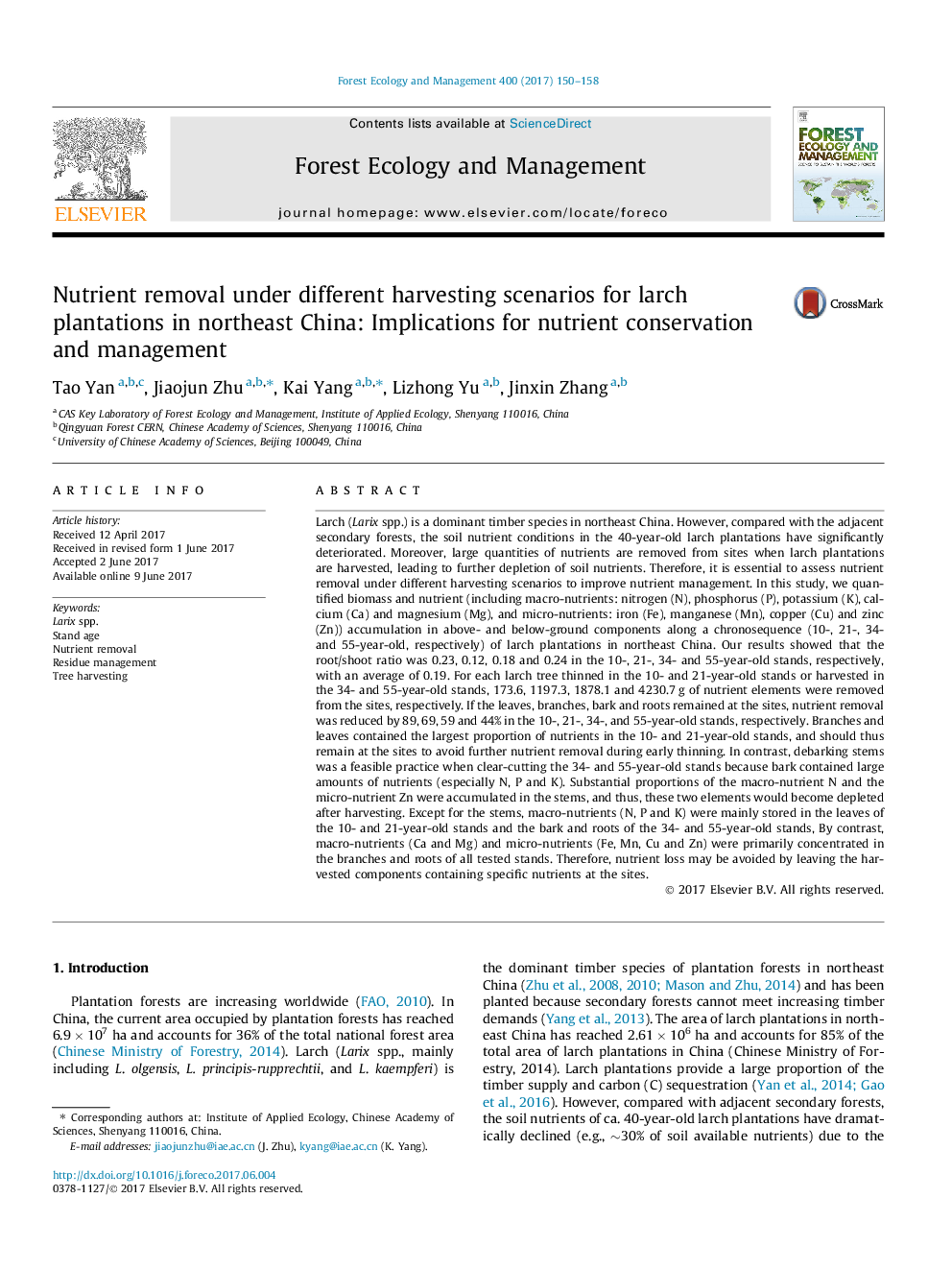| کد مقاله | کد نشریه | سال انتشار | مقاله انگلیسی | نسخه تمام متن |
|---|---|---|---|---|
| 6459219 | 1421358 | 2017 | 9 صفحه PDF | دانلود رایگان |
- Biomass and nutrient were qualified along a chronosequence of larch plantations.
- Root-shoot ratio significantly changed across the plantation chronosequence.
- Leaving logging residues at sites could reduce 44-89% nutrient removal.
- Branches, leaves in 10-, 21-, bark in 34-, 55-year-old should remain on-site.
- Macro-nutrient N and micro-nutrient Zn would potentially become depleted.
Larch (Larix spp.) is a dominant timber species in northeast China. However, compared with the adjacent secondary forests, the soil nutrient conditions in the 40-year-old larch plantations have significantly deteriorated. Moreover, large quantities of nutrients are removed from sites when larch plantations are harvested, leading to further depletion of soil nutrients. Therefore, it is essential to assess nutrient removal under different harvesting scenarios to improve nutrient management. In this study, we quantified biomass and nutrient (including macro-nutrients: nitrogen (N), phosphorus (P), potassium (K), calcium (Ca) and magnesium (Mg), and micro-nutrients: iron (Fe), manganese (Mn), copper (Cu) and zinc (Zn)) accumulation in above- and below-ground components along a chronosequence (10-, 21-, 34- and 55-year-old, respectively) of larch plantations in northeast China. Our results showed that the root/shoot ratio was 0.23, 0.12, 0.18 and 0.24 in the 10-, 21-, 34- and 55-year-old stands, respectively, with an average of 0.19. For each larch tree thinned in the 10- and 21-year-old stands or harvested in the 34- and 55-year-old stands, 173.6, 1197.3, 1878.1 and 4230.7Â g of nutrient elements were removed from the sites, respectively. If the leaves, branches, bark and roots remained at the sites, nutrient removal was reduced by 89, 69, 59 and 44% in the 10-, 21-, 34-, and 55-year-old stands, respectively. Branches and leaves contained the largest proportion of nutrients in the 10- and 21-year-old stands, and should thus remain at the sites to avoid further nutrient removal during early thinning. In contrast, debarking stems was a feasible practice when clear-cutting the 34- and 55-year-old stands because bark contained large amounts of nutrients (especially N, P and K). Substantial proportions of the macro-nutrient N and the micro-nutrient Zn were accumulated in the stems, and thus, these two elements would become depleted after harvesting. Except for the stems, macro-nutrients (N, P and K) were mainly stored in the leaves of the 10- and 21-year-old stands and the bark and roots of the 34- and 55-year-old stands, By contrast, macro-nutrients (Ca and Mg) and micro-nutrients (Fe, Mn, Cu and Zn) were primarily concentrated in the branches and roots of all tested stands. Therefore, nutrient loss may be avoided by leaving the harvested components containing specific nutrients at the sites.
Journal: Forest Ecology and Management - Volume 400, 15 September 2017, Pages 150-158
